Philippine crocodiles are critically endangered, with less than 100 individuals remaining in the wild. This drastic decline is primarily caused by habitat loss, illegal hunting, and climate change.
To combat these threats, organizations like the Mabuwaya Foundation are leading conservation initiatives that engage local communities in protecting these unique creatures.
Community-managed sanctuaries have been established, resulting in a significant reduction in crocodile killings. This is largely due to the positive attitudes fostered towards their conservation.
Additionally, breeding programs have increased genetic diversity, which is crucial for the species' survival.
Educational campaigns have been implemented to raise awareness about the ecological importance of Philippine crocodiles. These efforts have contributed to a better understanding of the species' role in maintaining a balanced ecosystem.
Ongoing research and restoration strategies are crucial for the recovery of Philippine crocodiles. By continuing these efforts, there is hope for the species to thrive once again.
Overview of Philippine Crocodiles
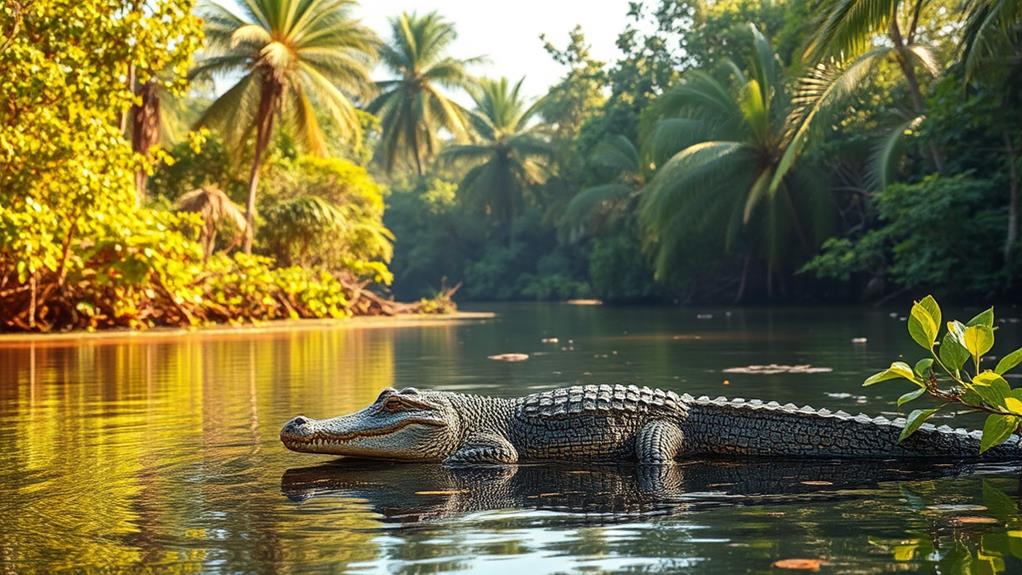
The Philippine crocodile is the most threatened crocodile species globally, with fewer than 100 individuals remaining in the wild.
This species is endemic to the Philippines, specifically inhabiting freshwater environments across Dalupiri, Luzon, and Mindanao islands.
Habitat fragmentation due to human activities significantly jeopardizes its survival.
Breeding typically occurs in January, with females laying clutches ranging from 7 to 30 eggs. This process showcases a fascinating temperature-dependent sex determination, where the incubation temperature determines the sex of the hatchlings.
However, the low population numbers and habitat loss hinder these natural reproductive cycles.
Conservation efforts are crucial in combating these threats. Organizations like the Mabuwaya Foundation are leading initiatives such as head start programs, which involve raising young crocodiles in safe environments before their release into protected habitats.
These efforts focus on community engagement, aiming to foster positive attitudes toward the Philippine crocodile and promote coexistence.
Physical Characteristics
Physical Characteristics of the Philippine Crocodile
The Philippine crocodile's unique physical characteristics are crucial for its survival and identification. Its brown coloration with distinctive black markings enables it to blend in with its natural habitat, making it an expert in camouflage. This adaptability is essential for the species' survival in the wild.
Body Structure and Size
The Philippine crocodile's heavily armored body structure provides protection against predators and environmental threats. In addition, its broad snout, typical of crocodiles, is a distinctive feature.
Notably, the Philippine crocodile is smaller than other crocodiles, making its size a unique identifier.
Conservation Importance
The Philippine crocodile's physical characteristics not only aid in its identification but also emphasize the importance of its conservation. As one of the rarest species, protecting this crocodile means safeguarding its unique adaptations that enable it to thrive in its environment.
Natural Habitat
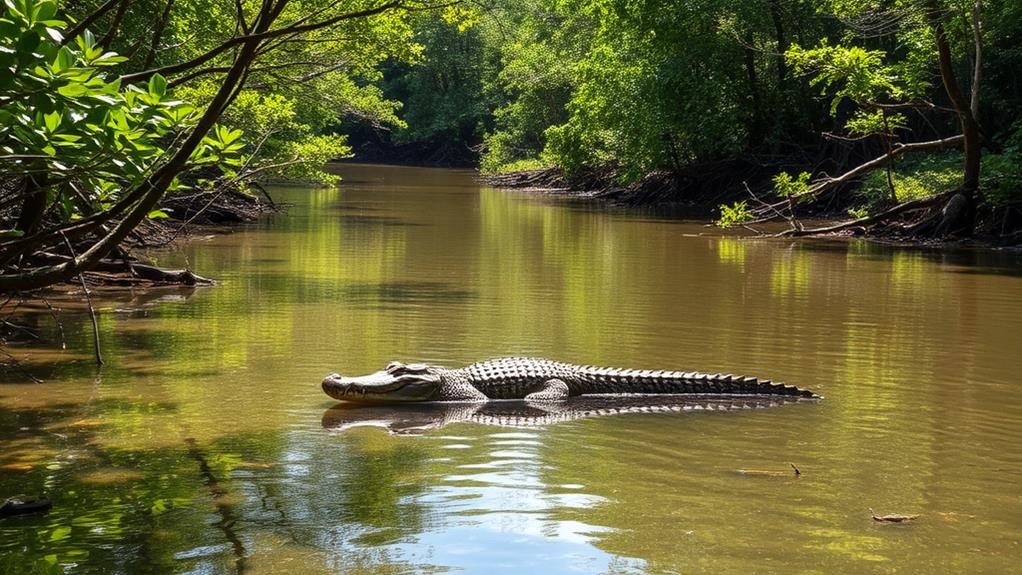
Philippine Crocodiles Rely on Freshwater Habitats for Survival
Philippine crocodiles thrive in freshwater environments, including rivers, ponds, and marshes, where they find the necessary resources for reproduction and daily life.
These habitats provide the perfect conditions for the crocodiles to survive, with access to food, water, and shelter. Unfortunately, human activities have severely impacted these habitats, leading to fragmentation that makes remaining populations more vulnerable to extinction.
Habitat Fragmentation Has Led to Population Isolation
Once widespread across the Philippines, Philippine crocodiles are now confined to specific islands like Dalupiri, Luzon, and Mindanao.
This isolation has resulted in fragmented populations, making it difficult for the species to thrive. As you explore their natural habitat, you'll notice the critical need for safe nesting sites.
These sites must meet specific conditions, such as temperature-dependent sex determination, crucial for the species' reproductive success.
Conservation Efforts Are Imperative for Survival
Conservation action has become imperative, particularly in areas like Northeast Luzon, where isolated populations struggle to survive.
Restoring these habitats not only helps the crocodile thrive but also supports the broader ecosystem. By understanding the importance of their natural habitat, you can appreciate the urgent need for concerted efforts to protect and restore these environments.
The future of the Philippine crocodile rests on preserving and restoring its natural habitat.
Breeding and Nesting
Breeding and Nesting in Philippine Crocodiles
Breeding and nesting are crucial stages in the life cycle of the Philippine crocodile, significantly impacting their population dynamics.
Breeding
Philippine crocodiles primarily breed in January, with clutch sizes ranging from 7 to 30 eggs.
Nesting Strategies
The species employs two nesting strategies: mound nests and hole nests.
Mound nests provide thermal regulation, while hole nests offer protection from predators.
Additionally, habitat selection influences survival rates.
Incubation and Sex Determination
The incubation period lasts approximately 65 to 85 days.
During this phase, the temperature determines the sex of the hatchlings.
Challenges and Conservation
Unfortunately, habitat loss and fragmentation have led to low hatchling survival rates, as safe water bodies for juveniles are increasingly scarce.
To address this, conservation efforts focus on protecting vital nesting sites and ensuring safe environments for hatching and juvenile crocodiles.
Current Conservation Status
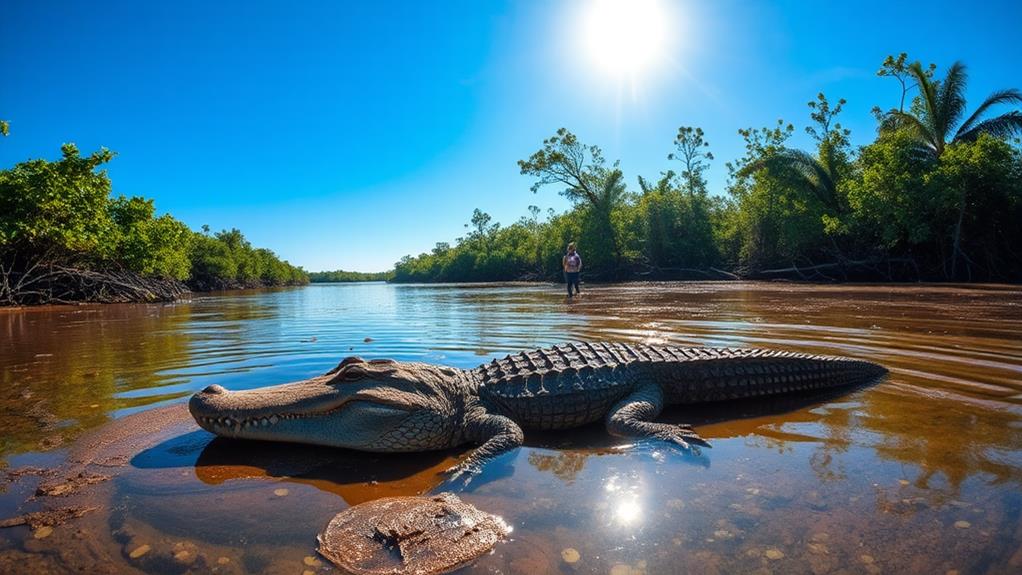
The current conservation status of the Philippine crocodile is critically endangered, with fewer than 100 individuals remaining in the wild. This situation highlights the urgency for effective conservation strategies to protect this species. Habitat loss and hunting are the primary threats, mainly because the Philippine crocodile's range is confined to specific islands in the Philippines. One approach to conserving the Philippine crocodile could involve exploring the diversity of Philippine dolphins, which may provide insights into the ecosystem dynamics and potential conservation measures for other endangered species in the region. Additionally, community-based conservation initiatives and captive breeding programs could play a crucial role in preventing the extinction of the Philippine crocodile. It is essential to prioritize research and conservation efforts to save this species from disappearing from the planet.
Conservation efforts are underway to address these challenges. Community-managed sanctuaries have been established, empowering local communities to manage and protect crocodile habitats. For example, the Mabuwaya Foundation has set up sanctuaries to safeguard the crocodiles' habitats.
Ex situ breeding programs have also been initiated, with European zoos collaborating to produce genetically pure Philippine crocodiles, essential for maintaining genetic diversity. Additionally, habitat rehabilitation initiatives focus on restoring habitats and engaging communities in conservation practices, aiming to foster a sustainable environment for the crocodiles.
These conservation efforts are crucial not just for the survival of the Philippine crocodile but also for restoring ecological balance in its native ecosystem.
Major Threats Faced
The Philippine crocodile is critically endangered, with fewer than 100 individuals remaining in the wild. This is due to several major threats that jeopardize its survival.
Habitat loss and fragmentation are significant threats. Human activities like agricultural expansion and urban development have destroyed much of their natural habitat, confining them to specific islands.
This not only threatens their existence but also disrupts the delicate balance of their ecosystem.
Illegal hunting and fear-based killings also exacerbate their declining numbers. People hunt them for their skins, and some kill them out of fear due to misconceptions about these creatures.
Low hatchling survival rates are another crucial factor. The lack of safe water bodies and suitable nesting sites makes it difficult for young crocodiles to thrive.
Climate change poses a growing threat, altering freshwater habitats essential for breeding and feeding.
This alteration affects the crocodiles' ability to survive and reproduce.
Preserving their habitat is crucial for their survival. The Philippine crocodile's future is precarious, and addressing these challenges is vital for ensuring this remarkable species can continue to exist in the wild.
Importance of Community Involvement
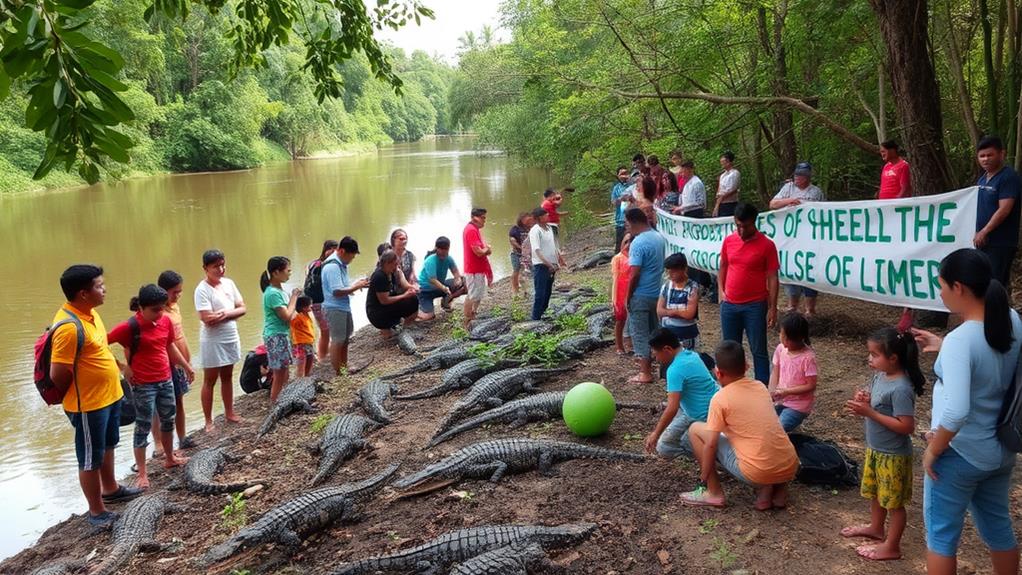
Community Involvement: A Key to Conservation Success
Community involvement has been instrumental in the conservation of the critically endangered Philippine crocodile. By engaging local communities, the crocodile population has increased from just 12 in 2001 to over 100 by 2012. This success is largely attributed to the efforts of the Mabuwaya Foundation, demonstrating the effectiveness of community-driven initiatives.
Three Crucial Aspects of Community Involvement
Education Transforms Mindsets: Educational programs have replaced fear with pride in local communities, shifting their perception of the Philippine crocodile. This transformation has led to a significant increase in support for conservation efforts.
Community-Managed Sanctuaries: The establishment of community-managed sanctuaries has enhanced local capacity for protecting the Philippine crocodile. These sanctuaries provide a safe habitat for the species, ensuring their continued survival.
Reduced Crocodile Killings: Through community engagement, the number of crocodile killings has drastically decreased, from 13 in 1998 to just 1 in 2013. This reduction is a direct result of the community's newfound appreciation and respect for the species.
Shared Responsibility for Biodiversity
With fewer than 100 non-hatchling Philippine crocodiles remaining in the wild, community involvement is crucial for the species' survival.
Successful Conservation Programs
Targeted conservation efforts have successfully revitalized the Philippine crocodile population. Since 2003, the Mabuwaya Foundation's head-start program has released young crocodiles into protected habitats, significantly bolstering wild populations.
This direct action has demonstrated the importance of targeted initiatives in crocodile conservation.
Collaborative projects have enriched our understanding of Philippine crocodile populations. The CROC Project, for instance, has provided scientific data and localized strategies, leading to a surge in population from 12 individuals in 2001 to over 100 by 2012.
This increase highlights the effectiveness of local initiatives.
Community engagement and management have led to substantial outcomes. The establishment of four community-managed crocodile sanctuaries since 2001 has drastically reduced crocodile killings, dropping from 13 in 1998 to just 1 in 2013.
This reflects a transformative shift in community attitudes toward these creatures.
Genetic purity is crucial for sustained conservation efforts. The European Studbook for Crocodylus mindorensis, initiated in 2012, ensures the genetic purity of the species, illuminating the path forward for the Philippine crocodile's survival.
Role of Captive Breeding
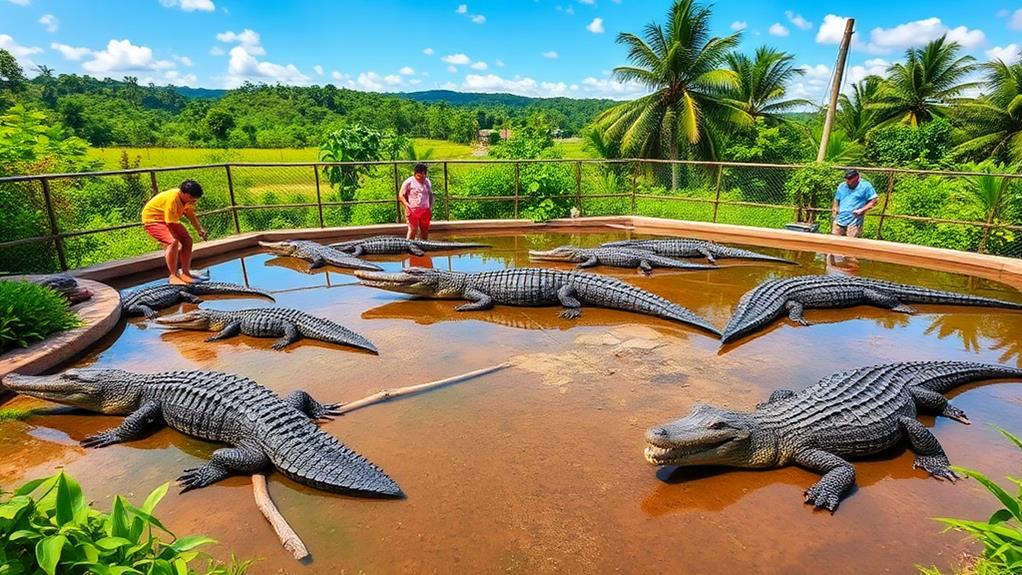
Targeted conservation efforts have laid a solid foundation for the Philippine crocodile's survival, but the role of captive breeding has emerged as a vital component of these initiatives.
Genetic Diversity is crucial for the long-term survival of the Philippine crocodile. Captive breeding initiatives, such as the European Studbook for Crocodylus mindorensis, document purebred crocodiles, ensuring a genetically diverse population. This is essential because it allows for the preservation of genetic traits that help the species adapt to changing environments.
Successful Reintroduction is another key aspect of captive breeding. The breeding of Philippine crocodiles in places like Cologne Zoo demonstrates the viability of ex situ conservation, allowing for the rearing of young crocodiles until they can be released into protected habitats.
This approach increases the chances of survival for released individuals, as they're bred in a controlled environment that mimics their natural habitat.
Collaborative Efforts between zoos have led to the repatriation of captive-bred crocodiles, enhancing wild populations and establishing a sustainable source for future reintroductions.
These partnerships are essential for the conservation of the Philippine crocodile, as they facilitate the exchange of genetic material and expertise between breeding programs.
Collaborative Conservation Efforts
Collaborative Conservation Efforts
Partnerships in Wildlife Protection
Collaborative conservation efforts are crucial for the survival of endangered species. The CROC Project is a prime example, where Dutch and Filipino students unite to gather crucial scientific data that informs conservation priorities for the Philippine crocodile.
Conservation Strategies
The Mabuwaya Foundation has played a vital role in conservation efforts since 2003 by implementing a head start program, releasing young crocodiles into protected habitats to boost their populations.
Community engagement has proven essential, leading to the establishment of four community-managed crocodile sanctuaries.
Population Growth
Thanks to these initiatives, the population of Philippine crocodiles surged from just 12 individuals in 2001 to over 100 by 2012.
The European Studbook for Crocodylus mindorensis, established in 2012, has maintained genetic purity and promoted successful breeding programs across European zoos, further contributing to the species' survival.
Effective Conservation
Ongoing communication with stakeholders and local communities has enhanced population estimates and monitored environmental changes, ensuring that conservation strategies remain effective.
Through these collaborative efforts, the future of the critically endangered Philippine crocodile looks increasingly hopeful, demonstrating the impact of unity in conservation.
Education and Awareness Initiatives
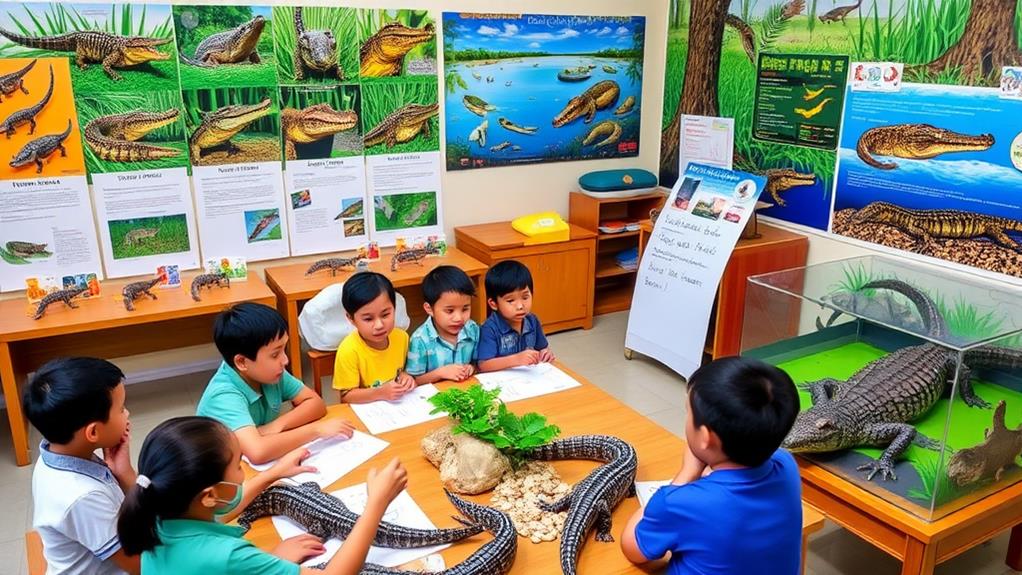
Education and awareness initiatives are crucial for community engagement and conservation efforts for the Philippine crocodile.
By educating local communities, these programs have significantly shifted perceptions, replacing fear with respect. The results are impressive; crocodile killings dropped from 13 in 1998 to just 1 in 2013.
Community-managed sanctuaries are a key component of these education initiatives. The Mabuwaya Foundation has established four sanctuaries since 2001, aiding population growth from 12 to over 100 crocodiles by 2012. This approach has helped to increase the crocodile population and promote coexistence with local communities.
Awareness campaigns are also essential in highlighting the ecological importance of crocodiles. These campaigns encourage coexistence rather than conflict by educating local communities about the role of crocodiles in the ecosystem.
Regular updates are necessary to keep the public informed about conservation efforts. Annual reports and media outreach have fostered greater involvement and support from local communities, leading to increased recognition of the value of protecting these critically endangered reptiles.
Through these educational efforts, local pride in the Philippine crocodile has flourished, demonstrating how effective education initiatives can transform attitudes and behaviors.
As communities gain knowledge, they increasingly recognize the value of protecting these critically endangered reptiles, ensuring a future where both people and crocodiles can thrive together.
Future Conservation Strategies
Future Conservation Strategies for Philippine Crocodiles
To ensure the sustainable conservation of Philippine crocodiles, community engagement and habitat restoration must be prioritized. This can be achieved by establishing two new community-managed sanctuaries, which will enhance local capacity for protection and foster a sense of ownership in conservation efforts.
For instance, the 2024 Conservation Leadership Programme (CLP) will empower local leaders, cultivating a grassroots movement that actively participates in preserving these critically endangered species.
Raising awareness is crucial for garnering community support. Educational campaigns by the Mabuwaya Foundation can shift local perceptions from fear to pride in their native crocodiles. This transformation is essential for the success of ongoing conservation initiatives.
Restoring and augmenting wild populations is vital. Repatriating young crocodiles from successful breeding programs in Europe will play a pivotal role in achieving this goal. This action not only boosts numbers but also strengthens genetic diversity.
Effective monitoring and evaluation are essential. Continued assessment of conservation strategies will ensure that efforts remain relevant and impactful, ultimately securing a future for the Philippine crocodile.
Research and Monitoring Activities
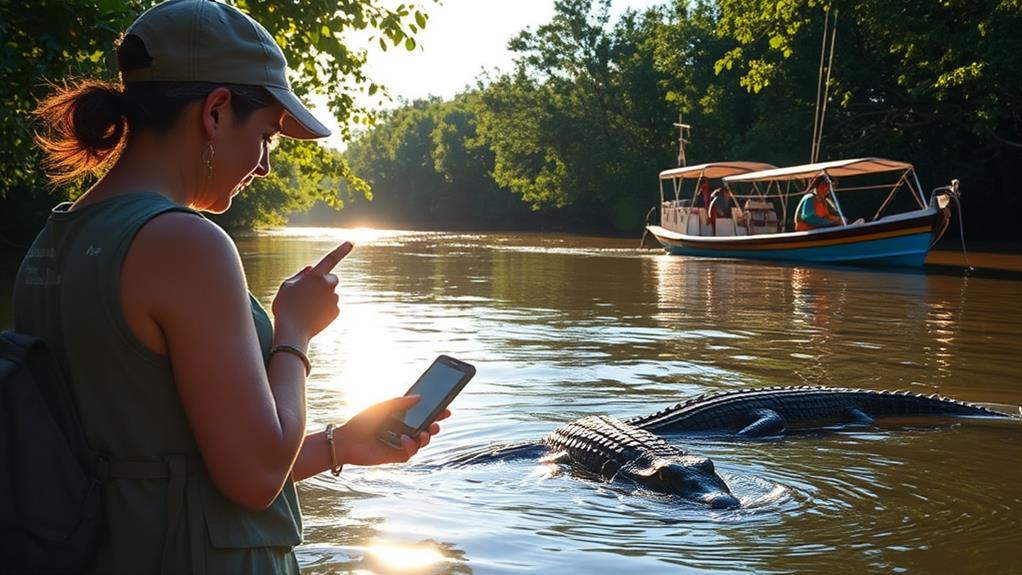
Safeguarding the Future of Philippine Crocodiles
To ensure the conservation of Philippine crocodiles, targeted research and monitoring activities are essential. These efforts identify overlooked populations, establish suitable field sites for intervention, and inform conservation strategies.
Local Engagement: Conducting interviews and surveys with local communities provides valuable data that might otherwise go unnoticed. This approach helps researchers understand the crocodiles' habitat, behavior, and population dynamics.
Genetic Analysis: Molecular analyses differentiate between pure Philippine crocodiles and hybrids, informing breeding recommendations and enhancing genetic diversity. This information is crucial for developing effective conservation plans.
Stakeholder Communication: Ongoing dialogue with stakeholders monitors environmental changes and improves population estimates. This collaboration ensures that all parties are informed and working together to protect the species.
The CROC Project plays a vital role in providing scientific data to shape local conservation priorities.
Annual reports and updates ensure transparency, foster community engagement, and keep stakeholders informed of progress and challenges.
Community Managed Sanctuaries
Community-managed sanctuaries have been crucial in conserving the Philippine crocodile.
Since 2001, the Mabuwaya Foundation has established four community-managed sanctuaries, which have significantly increased the population of this critically endangered species.
From 12 individuals in 2001, the numbers rose to over 100 by 2012. This success is largely due to local involvement in conservation efforts.
Local participation has drastically reduced crocodile killings. In 1998, there were 13 reported incidents of crocodile killings, which decreased to just 1 in 2013.
These sanctuaries focus on three key aspects: nest protection, habitat restoration, and educational campaigns. These efforts instill local pride and reduce fears about the Philippine crocodile.
Key aspects of community-managed sanctuaries include:
- Year Established: 2001
- Crocodile Population: 12 (2001), 100 (2012), and increasing (ongoing)
- Crocodile Killings: 13 (1998), 1 (2013), and decreasing (ongoing)
- Future Plans: Establishing 2 new sanctuaries to further reduce crocodile killings
These conservation efforts not only protect the Philippine crocodile but also empower local communities.
Global Significance of Conservation
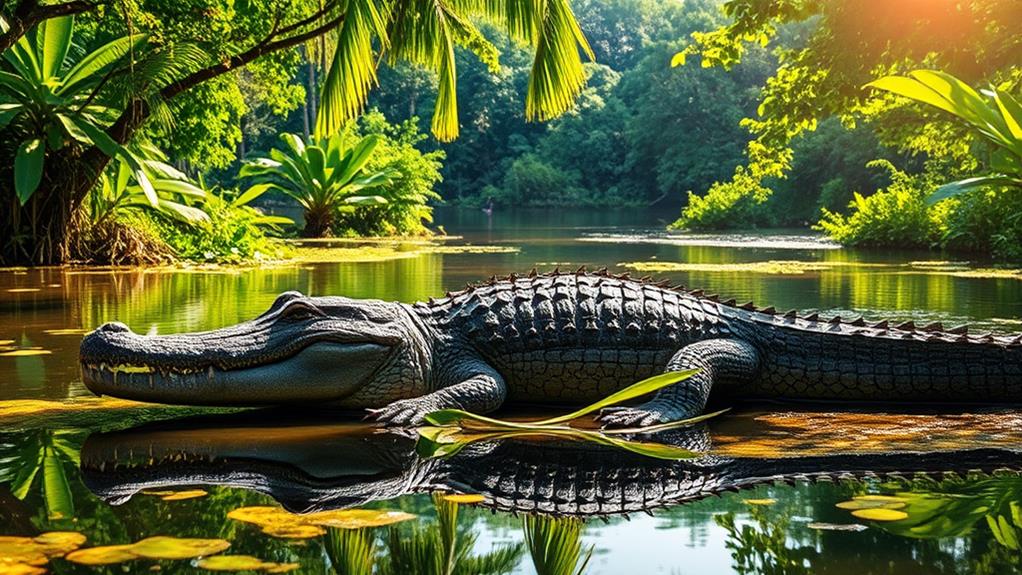
Conservation of the Philippine crocodile is crucial not only for its local ecosystem but also for maintaining global biodiversity.
The Philippine crocodile plays a vital role in its ecosystem as a top predator and scavenger. Its extinction would disrupt essential ecosystem services, leading to imbalances that affect other species and overall biodiversity.
There are three key reasons why conserving the Philippine crocodile matters globally:
Biodiversity Maintenance: The Philippine crocodile's unique role in its habitat is essential for maintaining biodiversity. For example, its predation and scavenging activities help regulate prey populations, which in turn maintain the balance of its ecosystem.
Ecosystem Services: The Philippine crocodile contributes to habitat health by controlling aquatic vegetation growth and maintaining water quality through its scavenging activities. This ensures the vitality of freshwater ecosystems, which support a wide range of plant and animal species.
Global Conservation Models: Successful conservation programs for the Philippine crocodile in the Philippines can serve as models for similar initiatives worldwide. These programs demonstrate how targeted actions, such as habitat preservation and species reintroduction, can lead to the recovery of endangered species.
Questions and Answers
What Is Critically Endangered Species in the Philippines?
Habitat Loss Threatens Critically Endangered Species in the Philippines
In the Philippines, habitat loss is the primary threat to critically endangered species. This is mainly caused by urban development and deforestation, which lead to the destruction of natural habitats.
Conservation Strategies Are Crucial for Survival
To ensure the survival of these species, conservation strategies are essential. These strategies aim to restore ecosystems and protect remaining habitats.
For example, the Philippine government has established protected areas, such as national parks and wildlife sanctuaries, to safeguard habitats and prevent further destruction.
Engaging Local Communities Is Key
Local communities play a vital role in conservation efforts. By educating them on the importance of preserving biodiversity, they can become active participants in protecting endangered species.
For instance, the Philippine Department of Environment and Natural Resources has launched programs to involve local communities in conservation efforts, providing them with alternative livelihoods and incentives to protect the environment.
Effective Conservation Measures Can Contribute to Recovery
By implementing effective conservation measures, it's possible to contribute to the recovery of critically endangered species in the Philippines.
This requires a collaborative effort from the government, local communities, and conservation organizations to restore habitats, monitor populations, and prevent further threats.
How Are Crocodiles Protected?
Crocodiles are protected through a combination of habitat preservation, community involvement, and laws that prohibit harm.
Effective habitat preservation is crucial for crocodile conservation. For instance, national parks provide a safe haven for these reptiles, safeguarding their ecosystems and allowing them to thrive.
Laws prohibiting the harm of crocodiles are strictly enforced, ensuring their protection.
Community involvement is also vital in conservation efforts. Local communities manage sanctuaries, fostering a sense of ownership and responsibility. This collaborative approach not only enhances the crocodile population but also promotes awareness about their ecological importance.
By engaging with local stakeholders, we can ensure a sustainable future for these magnificent reptiles.
Collaborative conservation initiatives enhance the crocodile population and promote awareness about their ecological importance.
What Is Bukarot?
Bukarot, the local name for the Philippine crocodile, is a critically endangered species. It primarily inhabits freshwater ecosystems, where it plays a crucial role in maintaining balanced aquatic environments.
The presence of bukarot indicates a healthy habitat, which is essential for biodiversity.
There are fewer than 100 bukarot individuals left, which has a significant impact on both local ecology and cultural heritage.
Understanding the significance of bukarot can drive conservation efforts and foster community respect for this unique species.
What Is the Distinction of the Philippine Crocodile?
The Philippine crocodile is distinguished by its unique physical characteristics. It has a brown coloration with distinct black markings and a broad snout, setting it apart from other species.
The Philippine crocodile has specific habitat preferences. It thrives in freshwater habitats such as rivers, ponds, and marshes, primarily found on specific islands in the Philippines.
These habitats are crucial for its survival and play a vital role in the ecosystem, where the Philippine crocodile functions as both a predator and scavenger.